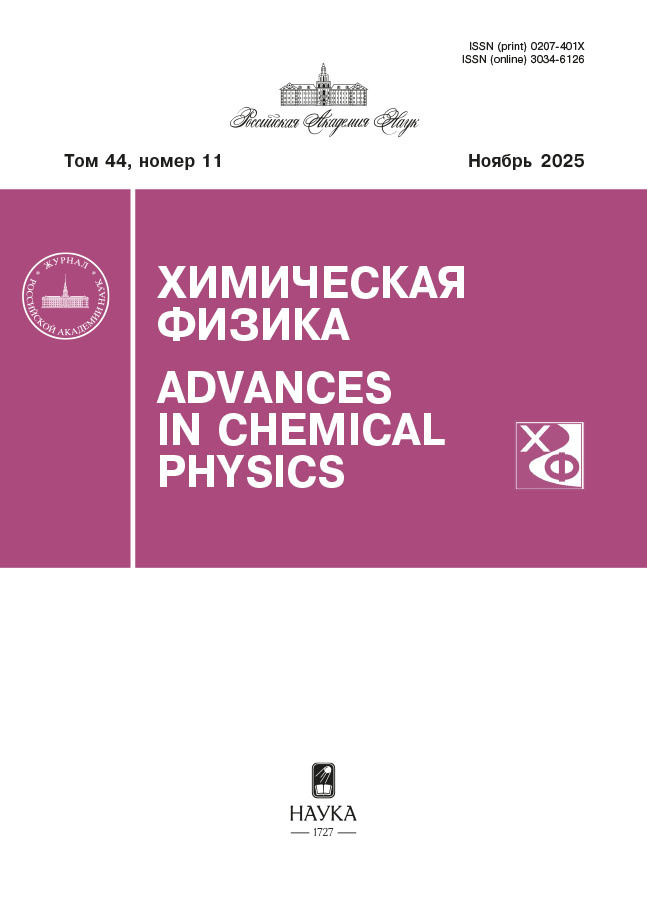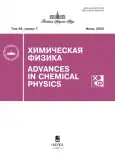Pulsating Combustion of a Hydrogen-Air Mixture in a Channel with Sudden Expansion
- Authors: Fedorova N.N.1
-
Affiliations:
- Khristianovich Institute of Theoretical and Applied Mechanics of the Siberian Branch of the Russian Academy of Sciences
- Issue: Vol 44, No 7 (2025)
- Pages: 73-92
- Section: Combustion, explosion and shock waves
- URL: https://modernonco.orscience.ru/0207-401X/article/view/687631
- DOI: https://doi.org/10.31857/S0207401X25070081
- ID: 687631
Cite item
Abstract
A high-speed turbulent reacting flow in a channel with a sudden expansion in the form of two symmetrically located steps is numerically investigated. Various combustion phases are described: initial phase with low combustion completeness and intensive one with high combustion completeness. In the intensive phase, depending on the heat release power, a pulsating (self-oscillating) combustion mode can be realized with periodic movement of the intensive heat release zone upstream and downstream and also a mode with thermal choking, in which the shock formed in the thermal throat, spreading upstream, enters the narrow injector channel part and blocks the flow. The transition to subsonic flow occurs if the heat release exceeds the total heat flux at the inlet by one and a half times or more. The pulsating mode, in which the velocity in the flow core remains supersonic, is realized if the total heat release power is approximately equal to the heat flux at the channel entrance. An analysis of the stages of the pulsating nonpremixed hydrogen-air combustion showed that the flame flashback accompanied by an increase in heat release, is caused by the boundary layer separation and the formation of a hot wall jet directed toward the step, i.e. against the core flow. After the heat source has stabilized at the beginning of the channel, the heat source power decreases due to the complete burnout of the oxidizer, as a result of which the thermal throat expands and fresh reagents enter the channel. At the end of the channel straight section, a new heat source is formed, which starts moving upstream, and the whole process is repeated periodically.
Full Text
About the authors
N. N. Fedorova
Khristianovich Institute of Theoretical and Applied Mechanics of the Siberian Branch of the Russian Academy of Sciences
Author for correspondence.
Email: nfed@itam.nsc.ru
Russian Federation, Novosibirsk
References
- Anderson J.D. Fundamentals of Aerodynamics. New York: McGraw-Hill, 2007.
- M. Sun, H. Wang, Z. Cai, J. Zhu Unsteady Supersonic Combustion. Singapore: Springer, 2020. https://doi.org/10.1007/978-981-15-3595-6
- Liberman M.A. Combustion Physics: Flames, Detonations, Explosions, Astrophysical Combustion and Inertial Confinement Fusion. Springer Int. Publ., 2021.
- Larionov V.M., Zaripov R.G. Gas Self-Oscillations in Combustion Installations. Kazan: Publishing house of Kazan. state technical university, 2003. 227 pp.
- Meng X., de Jong W., Kudra T. // Renew. Sust. Energ. Rev. 2016. V. 55. P. 73. https://doi.org/10.1016/j.rser.2015.10.110
- Poinsot T. // Proc. Comb. Inst. 2017. V. 36. № 1. P. 1. https://doi.org/10.1016/j.proci.2016.05.007
- Rauschenbach B.V. Vibrational combustion. Moscow: Fizmatgiz, 1967.
- Lieuwen T. C. Unsteady Combustor Physics. Cambridge: Cambridge University Press, 2021. https://doi.org/10.1017/9781108889001
- Mejia D., Selle L., Bazile R., Poinsot T. // Proc. Combust. Inst. 2015. V. 35. № 3. P. 3201. https://doi.org/10.1016/j.proci.2014.07.015
- Choi J.-Y., Ma F., Yang V. // Ibid. 2005. V. 30. P. 2851. https://doi.org/10.1016/j.proci.2004.08.250
- Lin K.-C., Jackson K., Behdadnia R. et al. // J. Propul. Power. 2010. V. 26. P. 1161. https://doi.org/10.2514/1.43338
- Wang H., Wang Z., Sun M. // Exp. Therm. Fluid Sci. 2013.V. 45. P. 259. https://doi.org/10.1016/j.expthermflusci.2012.10.013
- Wang H., Wang Z., Sun M., Wu H. // Sci. China Technol. Sc. 2013. V. 56. P. 1093. https://doi.org/10.1007/s11431-013-5198-1
- Wang H., Wang Z., Sun M., Qin N. // Int. J. Hydrogen Energ. 2013. V. 38. P. 5918. https://doi.org/10.1016/j.ijhydene.2013.02.100
- Ouyang H., Liu W., Sun M. // Acta Astronaut. 2015. V. 117. P. 90. https://doi.org/10.1016/j.actaastro.2015.07.016
- Han Y., He Y., Tian Y., Zhong F., Le J. // Aerosp. Sci. Technol. 2018. V. 72. P. 114. https://doi.org/10.1016/j.ast.2017.11.003
- Zhao G.-Y., Sun M.-B., Song X.-L., Li X.-P., Wang H.-B. // Acta Astronaut. 2019. V. 155. P. 255. https://doi.org/10.1016/j.actaastro.2018.12.011
- Nguyen T.M., Sirignano W.A. // AIAA J. 2019. V. 57. P. 5351. https://doi.org/10.2514/1.J057743
- Vlasenko V.V., Sabelnikov V.A., Molev S.S. et al. // Shock Waves. 2020. V. 30. P. 245. https://doi.org/10.1007/s00193-020-00941-4
- Jeong S.-M., Han H.-S., Sung B.-K. et al. AIAA Paper 2021-3535. https://doi.org/10.2514/6.2021-3535
- Jeong S.-M., Han H.-S., Sung B.-K. et al. // Aerospace. 2023. V. 10. P. 932. https://doi.org/10.3390/aerospace10110932
- Wang T., Wang Z., Sun M., Li F., Huang Y. // AIAA J. 2023. V. 61. P. 2591. https://doi.org/10.2514/1.J062051
- Guo S., Zhang X., Liu Q., Yue L. // Phys. Fluids. 2023. V. 35. P. 045108. https://doi.org/10.1063/5.0142210
- Jeong S.-M., Lee J.-H., Choi J.-Y. // Proc. Combust. Inst. 2023. V. 39. P. 3107. https://doi.org/10.1016/j.proci.2022.07.245
- Boulal S., Genot A., Klein J.-M. et al. // Combust. Flame. 2023. V. 257. P. 112999. https://doi.org/10.1016/j.combustflame.2023.112999
- Mohamadi M., Tahsini A. M., Tavazohi R. // Int. J. Hydrogen Energ. 2024. V. 67. P. 769. https://doi.org/10.1016/j.ijhydene.2024.04.205
- Yasunaga S., Nakaya S., Tsue M. // Proc. Combust. Inst. 2024. V. 40. P. 105302. https://doi.org/10.1016/j.proci.2024.105302
- Zhang L., Li S., Liu T., Zhou H., Ren Z. // Int. J. Hydrogen Energ. 2025. V. 97. P. 444. https://doi.org/10.1016/j.ijhydene.2024.11.402
- Zakharova Y.V, Fedorova N. N., Goldfeld M. A., Vankova O. S. // J. Phys. Conf. Ser. 2019. V. 1382. P. 012055. https://doi.org/10.1088/1742-6596/1382/1/012055
- Fedorova N.N., Goldfeld M.A. // Tech. Phys. Lett+. 2021. V. 47. № 1. P. 50. https://doi.org/10.1134/S1063785021010193
- Fedorova N. N., Vankova O. S., Goldfeld M. A. // Combust. Explo. Shock+. 2022. V. 58. P. 127. https://doi.org/10.1134/S00105082220200
- Fedorova N. N., Goldfeld M. A., Pickalov V.V. // Combust. Explo. Shock+. 2022. V. 58. P. 536. https://doi.org/10.1134/S0010508222050057
- Fedorova N. N., Goldfeld M. A., Pickalov V. V. // Combust. Explo. Shock+. 2022. V. 58. P. 546. https://doi.org/10.1134/S0010508222050069
- Fedorova N. N. // Combust. Explo. Shock+. 2023. V. 59. P. 402. https://doi.org/10.1134/S0010508223040020
- Goldfeld M.A. // Thermophys. Aeromech+. 2020. V. 27 P. 573. https://doi.org/10.1134/S0869864320040101
- Maas U., Warnatz J. // Combust. Flame. 1988. V. 74. № 1. P. 53. https://doi.org/10.1016/0010-2180(88)90086-7
- Vankova O.S., Fedorova N.N. // Combust. Explo. Shock+. 2021. V. 57. P. 398. https://doi.org/10.15372/FGV20210402
- Yamashita H., Shimada M., Takeno T. // Proc. Combust. Inst. 1996. V. 26(1). P. 27. https://doi.org/10.1016/S0082-0784(96)80196-2
- Gerlinger P., Stoll P., Kindler M., Schneider F., Aigner M. // Aerosp. Sci. Technol. 2008. V. 12(2). P. 159. https://doi.org/10.1016/j.ast.2007.04.003
Supplementary files





















